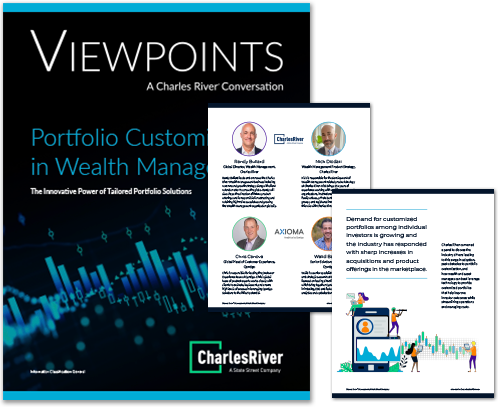
NICK: We’re seeing three main trends supporting the movement toward portfolio personalization. First, consumers increasingly expect to have experiences tailored to their preferences, from news to music to shopping. Those expectations apply to their investment portfolios, and the wealth industry is responding by providing digital experiences that are easy for retail investors to navigate. Second are the broad, fundamental shifts happening in the industry. Customized portfolios have typically been offered only to high-net worth investors through separately managed accounts (SMA), which were historically complex and costly to administer at lower asset thresholds. However, the recent availability of fractional shares and $0 trading fees have removed those barriers, opening the door for personalized portfolios on a larger scale. Finally, rapidly advancing technology is providing the infrastructure to bring customization to the market. Cloud-native technology with the scalability to process large volumes accompanied by analytics-driven approaches to portfolio construction enable managers to operate custom portfolios at scale in a cost-effective way.
CHRIS: You touched on some critical points that reflect what
we’re seeing in the industry and among clients. They’re familiar with
customization; but there is significant complexity in implementing and
operating these portfolios. For example, balancing risk tradeoffs
while implementing a number of constraints into the portfolio or
optimizing for tax considerations can be complicated without the right
tools.
Streamlining that complexity in the portfolio construction process
requires a powerful optimizer that can accommodate the scale needed to
manage the volume of retail portfolios. Cloud-based and scalable
technology is crucial to offering personalized portfolios. These
capabilities that have been available for institutional use cases for
a long time are more available for a greater number of market
participants in a sustainable way, which is really exciting.
The next step is financial advisor adoption – they need the right
optimization settings and features that are intuitive and efficient
without creating additional costs or operational headaches, barriers
they have often faced with customization in the past.
NICK: Financial advisors understand customization, but adoption
among financial advisors comes down to practical questions around
practice management. Advisors have typically approached customization
in one of two ways: outsourcing to a third party with that expertise
or choosing to do it themselves in-house with their own proprietary
applications.
Outsourcing requires the advisor give up control to the third party,
necessitating a level of trust that the desired customizations will be
correctly implemented. In-house customization helps advisors retain
control but can introduce additional costs, risk, and inefficiency
into their practice. If advisors take on customization themselves, the
tools they’re using often do not have the scalability needed to
operate these portfolios efficiently and in a cost-effective way.
In order to adopt customization, advisors need greater understanding
and visibility into the portfolio construction process. Education is
also an important component to help advisors better understand the
value of changing their approach and relinquishing control. It’s also
a mindset shift where the advisor needs to know what’s going on with
each end investor – these portfolios reflect each and every
individual. It’s no longer a single portfolio that gets homogenized
across a set approach or asset allocation guidance.



WALID: The right technology tools can certainly overcome barriers. Wealth firms and advisors want a sophisticated solution that not only allows them to trade off losses, model or benchmark drift, and risk, but also offers personalization. Having easy to consume trade rationale, attribution, and analytics capabilities are also important. They want to know the rationale behind why certain trades are being made. Accomplishing all of this at scale with manual processes is very difficult.
WALID: There are certainly many factors that go into adopting customization, whether you build a solution in-house or acquire a platform provider. Many firms are most concerned with speed to market. Acquisition might enable you to go to market with a product more quickly, but there is a tradeoff when you consider an in-house solution that’s flexible and integrates with your internal systems environment seamlessly. However, these solutions are a big lift to build. The question is managing that tradeoff between speed and a purpose-built solution.
WALID: Firms may not want to build in house or acquire a platform.
Technology providers are trying to solve for that by creating a
technology offering that avoids the downsides of build vs. buy.
There’s no need to acquire a technology provider nor is it necessary
to take on a time-consuming and costly IT project. Technology
solutions can offer the best of both worlds while still allowing for a
flexible solution that integrates with your environment and allows you
to go to market quickly.
Of course, there is variability among technology offerings and their
level of capability. For wealth firms, scalability is a crucial
feature – you want a solution that can handle the volume requirements
of large, enterprise firms as well as the customization requirements
across thousands of accounts. Another component to look for is
interoperability. An open architecture solution enables the
integration of internal and external datasets, allowing firms to
leverage the data that would help them achieve their goals. These
facets are very much “under the hood,” and certainly, user experience
and ease of use are extremely important. The key is to ensure that the
underlying technology provides a powerful engine and doesn’t limit the
customization capabilities.
CHRIS: One of the common trends we see in the firms we work
with is the necessity to look at their portfolio construction and
operational processes when adopting portfolio customization. Within
the portfolio construction process, managers have to balance
incorporating their best ideas with the stated portfolio
customizations and constraints, whether it’s tax optimization or ESG
values.
This adds more complexity to the process and we consult with firms to
help them understand the changes that might be needed, walking through
workflows and identifying challenges and potential solutions. For
example, when adopting personalized portfolios, they may want to
consider an optimization-based process instead of a rules-based
process.
NICK: There has been significant interest in portfolio
customization in the separate account space and they struggle with the
same challenges as wealth managers and advisors. For these use cases,
leveraging a technology solution with optimization capabilities will
allow them to overcome those challenges by allowing them to achieve
the efficiency and scale needed without additional headcount. Their
portfolio management process becomes simpler because the portion that
was previously so complex – the customization – is handled by the
optimization engine, accomplishing this step far more efficiently than
before. The technology now does the heavy lifting.
RANDY: Another way to think about portfolio customization in
the separate account space is as a countervailing force against the
industry trend toward models. While model distribution is efficient
and simple to operate, the fees are lower and the value is lower. With
separate accounts, firms see the opportunity to distribute their
intellectual property in the form of alpha signals, capital market
assumptions, or assumptions about risk, ESG datasets, and put that
intellectual property or data into a personalized portfolio
strategy.
RANDY: In partnership with Qontigo, we have built a technology
offering, Tailored Portfolio Solutions, that provides a flexible,
open, and scalable workflow for portfolio customization. One of the
differentiators of the solution is embedding the Axioma Portfolio
Optimizer directly into Tailored Portfolio Solutions’s workflow.
Combining Charles River’s open architecture platform with a powerful
optimization engine allows the manager to incorporate both proprietary
and third-party data sources for customization, with the efficiency
and scalability to implement those customizations across large numbers
of accounts, capital market assumptions, or assumptions about risk,
ESG datasets, and put that intellectual property or data into a
personalized portfolio strategy.
CHRIS: The wealth industry is in the middle of a dynamic shift
and it’s exciting to see the market embracing new technologies and the
speed of that change. Portfolio customization for retail investors is
taking off and the next few years will be dynamic as different
solutions and products come to market, showing the outcome of many of
the topics we’ve discussed today. Stay tuned.
Learn more about Charles River’s TPS Capabilities at
crd.com/tps


Learn more about what State Street Alpha can do for you.
Please provide your information and a member of our client services team will contact you promptly.


